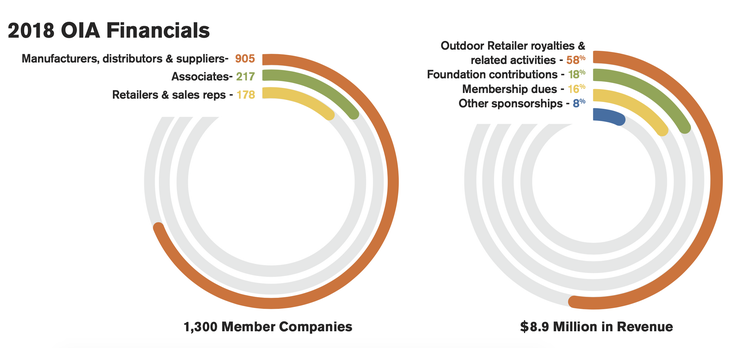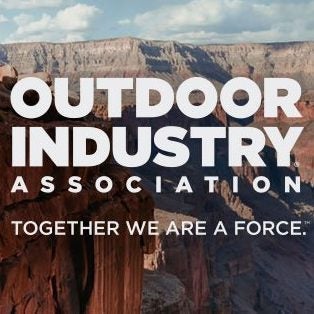How do I apply for a paycheck protection loan? What if I have to furlough employees? How do I pivot my manufacturing to make PPEs? What if I have to close my business? These are the types of questions the Outdoor Industry Association fielded when its 1,300 member businesses began calculating the economic impacts of the months-long coronavirus quarantine. OIA immediately changed course and established a COVID-19 resource hub, and redirected everyone on staff to work on coronavirus response.
It would have been a challenging pivot in the best of times, but the pandemic came at a crux moment for OIA. The crisis threatens the 31-year-old organization’s funding model—which was already under pressure—and OIA’s new executive director, Lise Aangeenbrug, took office just a week before stay-at-home orders started shuttering outdoor businesses around the country.
“There’s no roadmap for this,” Aangeenbrug said. “Our singular goal right now is to help our members survive.”
But by prioritizing its members, OIA is putting off a question of its own, one that it must answer from within: How will OIA survive this? Is OIA itself healthy and strong enough to be the beacon of leadership that the industry needs right now, and in the future?
OIA’s Complex Relationship with Outdoor Retailer
Even before the crisis, OIA faced a potentially unreliable long-term funding model, with most of its eggs in the basket of Outdoor Retailer. OIA’s $8.9 million annual revenue comes, in large part, from Outdoor Retailer royalties (58 percent). The remaining revenue comes from Outdoor Foundation donations (18 percent), membership dues (16 percent), and other sponsorships (8 percent).
In many ways, it’s a smart model because OIA doesn’t have to constantly ask its members for more money, says Phyllis Grove, OIA board member and VP of marketing and ecommerce at Hydro Flask. (Annual membership fees range from $250 to $30,000 depending on the size and type of the organization.)
However, it also puts OIA at risk. Even with healthy reserves, Aangeenbrug says, OIA needs the national trade show, otherwise it would be in trouble. Now OIA is in that troubling situation. In response to the pandemic, Outdoor Retailer canceled the 2020 Summer Market. A few weeks later, VF Corporation chipped in 15 percent ($55,000) of its Summer Market refund to OIA, recognizing that the cancellation creates “a critical funding gap in OIA’s traditional revenue stream,” Smartwool (part of VF) Brand President Jen McLaren said in a news release. A few other brands—Patagonia, W.L. Gore, Hydro Flask, and NEMO among them—followed suit. And on June 1, OIA made the tough ask to the broader industry. Nora Stowell, board chair, in a letter urged members to make a donation that replaces the royalty fee brands would have paid through exhibiting costs. “The health of OIA is tied to the health of the industry,” she wrote.
“When they canceled this year’s show, I thought, ‘I don’t know how OIA is going to survive,’” said Carolyn Brodsky, co-founder of Sterling Rope Company. She has been among those in the industry to question Outdoor Retailer’s relevance and cost structure, as well as protest OIA’s dependency on the trade show, but she believes the association has an important leadership role to play.
Peter Sachs is of a similar mindset. As the general manager of LOWA and a member of OIA, he relies on the trade show for business. But, “To me, [OIA] sold their soul when they agreed to endorse Outdoor Retailer exclusively,” Sachs said. “I wish they had owned it and then gotten an organization like Emerald Expositions to run it for them. OIA’s future is controlled by a corporation that’s not in the outdoor, ski, or bike industry. They’re in the trade show industry.”
Wrestling with Revenue
Revenue diversification has been on OIA’s slate for the entire 11 years Travis Campbell, VF president of emerging brands and Americas platforms, has served on the board. Because the partnership with Emerald Expositions, Outdoor Retailer’s owner, remains strong, he says, nothing signaled to the board that they needed to make a sudden, drastic change. Change has always been incremental. For example, new programs like the Skip Yowell Future Leadership Academy and the Futurist Project brought in $100,000 in (combined) sponsorship funds.
In January, OIA gathered a task force to discuss funding alternatives—part of its ongoing efforts to tackle the problem. By March, when it became clear that its members were focused on trying to meet their own basic financial needs, OIA decided to table the discussion about its own funding model. “It’s hard to talk to people about money when they’re hurting,” Aangeenbrug said.

Another new, revenue-producing program, the Outdoor Industry Business Certificate, was due to launch in early 2020. OIA now expects it to go live later in 2020, with university partners like Utah State University and Western Colorado University. Still, the annual revenue it would generate is small potatoes compared to the more than $5 million from Outdoor Retailer.
“It’s time to have a more transparent conversation with our members about funding,” Hydro Flask’s Grove said. “It’s very clear that with the cancellation of the summer show, we have to accelerate the way that we request more money from members.”
Shifting to a direct dues model—a much higher cost for members—is the only real solution for relieving OIA entirely of its dependency on Outdoor Retailer, says Campbell. But to do that, he said OIA has to be clear on its value proposition: “You have to deliver a lot of value if you’re going to ask for more money and that’s the part we continue to wrestle with.”
Shelley Dunbar, co-owner of Neptune Mountaineering and former co-owner of Sea to Summit, says she would much rather pay a higher OIA membership rate and see OIA put on its own smaller show than pay gobs of money to the for-profit trade show that’s often unattainable for the smaller brands who make the industry competitive. “It’s the single biggest expense in our marketing budget,” she said.
As Campbell sees it, though, it’s not an either/or conversation. He believes that while trade shows overall are struggling, OIA’s cut from Outdoor Retailer will never drop to zero because he has faith in OR. “Who knows, they may not even be called trade shows in the future,” Campbell said. “But OR will figure out an economic model that works for them that supports this industry.”
Time to Shine
During crisis, a trade association has the opportunity to be an invaluable resource. OIA was quick to establish a COVID-19 hub, which Grove found invaluable.
Dunbar, however, wishes OIA used this time to refocus on the trade membership. Yes, fighting for public lands is important, she says, but there are other groups that can and should take the lead, like The Conservation Alliance and The Access Fund. Retailers are a subset of the industry that has been underserved, Brodsky and Dunbar say. “It would be beneficial for me if OIA enabled retail members to share information like best practices, best software, and point of sale systems, or if they brought back the Retail Benchmarking Report,” Dunbar said.
There’s also work to do on the diversity front, both internally and externally. OIA knows it has a responsibility to better integrate more BIPOC voices and make JEDI progress across all programs. And to help members do the same, OIA says it will host facilitated sessions this summer with people from diverse backgrounds educating industry leaders.
Once the pandemic crisis settles down, Aangeenbrug says she looks forward to getting back to moving the outdoor industry forward. She cites the Climate Action Corps, a program launched in January to help companies reduce their greenhouse gas emissions, as one such initiative. And of course, OIA’s future funding model will be top of mind as the industry moves into an uncertain trade show future.
Whatever the fix, Brodsky wants to see OIA lead and innovate: “This is a time when retailers and organizations and members need their association the most.”
This story originally ran in the Summer 2020 issue of The Voice.


